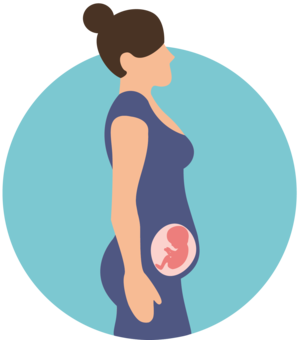Pregnancy at week 24
4-minute read
Your baby
Your baby is now about 25cm long – about the size of a very large corn cob. They weigh from around 0.6kg to around 0.7kg.
Your baby's brain is growing rapidly and their senses are continuing to develop. The tastebuds on their tongue are growing and becoming more sensitive, their eyes respond to light and they can hear sounds from outside the uterus.
Their lungs are developing too. They are growing branches and getting ready to produce surfactant, the substance that will enable the lungs to expand when your baby is breathing.
Preterm babies born at 24 weeks have about a 1 in 2 chance of surviving if they are delivered in hospital and receive expert care in a neonatal unit. However, they would have a high chance of having a disability, such as cerebral palsy or blindness, if they were born this early.
Your baby at 24 weeks
| Length: | 21cm |
| Weight: | 630g |

Your body
The top of your uterus is just above your belly button now. As the baby’s movements get stronger, you might be able to feel them by placing your hand on your tummy. You might find other people making comments about your pregnancy or even trying to touch your tummy, which might make you feel uncomfortable.
You may start to feel Braxton Hicks contractions from now on. These are a type of contraction when the muscles of your uterus tighten and your bump goes hard. You can tell the difference between Braxton Hicks contractions and labour contractions because they aren’t regular and they will probably stop if you shift position.
Always seek medical attention if you experience:
- contractions that become stronger, more frequent or that last longer
- persistent pain or pressure in your tummy, back or pelvis
- vaginal bleeding
- your baby’s movements slowing or stopping
Things to remember
At some time between 24 and 28 weeks, you might be offered a test for gestational diabetes. This is a type of diabetes that develops in pregnancy and goes away once the baby is born.
The test is called a Glucose Tolerance Test (GTT). It’s a blood test that you have after you have fasted for 8 to 12 hours. You then have a glucose drink and 1 to 2 hours later you have another blood test.
If the GTT shows you have gestational diabetes, you can manage the condition by monitoring your blood sugar, making changes to your diet, exercising, and sometimes taking medication. You will need extra care for the rest of your pregnancy.
Read next

Your pregnancy at 25 weeks
Learn about your pregnancy journey and what is happening to you and your baby.

Speak to a maternal child health nurse
Call Pregnancy, Birth and Baby to speak to a maternal child health nurse on 1800 882 436 or video call. Available 7am to midnight (AET), 7 days a week.
Learn more here about the development and quality assurance of healthdirect content.
Last reviewed: August 2020




